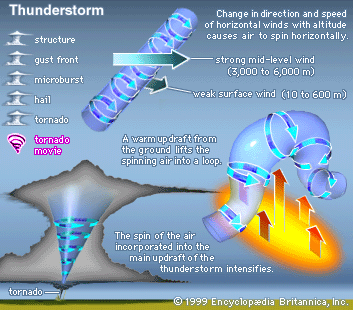
WelcomeToTornado Home Page

Tornado Formation
Tornadoes form from thunderheads, or anvil clouds, during very severe electrical storms, known as supercells. Supercells are significantly longer, rotating thunderstorms, typically lasting several hours and are over 6 miles in diameter.
During a supercell, there is an updraft, a current of warm, moist air rising through the electrical storm, which gives the storm its long-living properties. Then, if the wind intensity varies correctly with height, the updraft begins to rotate in the mid-levels of the atmosphere. This rotating updraft is known as a mesocyclone.
Next, in order for a tornado to develop, a strong current of cool air must move downward from the back of the storm. This downward current, known as a rear-flank downdraft occurs due to the density of colder air in comparison to warm air, which causes cold air to sink as warm air rises. As the speed of the downdraft increases to speeds up to 100 miles per hour, a tornado forms between the rear-flank downdraft and the updraft.
Tornadoes form from thunderheads, or anvil clouds, during very severe electrical storms, known as supercells. Supercells are significantly longer, rotating thunderstorms, typically lasting several hours and are over 6 miles in diameter.
During a supercell, there is an updraft, a current of warm, moist air rising through the electrical storm, which gives the storm its long-living properties. Then, if the wind intensity varies correctly with height, the updraft begins to rotate in the mid-levels of the atmosphere. This rotating updraft is known as a mesocyclone.
Next, in order for a tornado to develop, a strong current of cool air must move downward from the back of the storm. This downward current, known as a rear-flank downdraft occurs due to the density of colder air in comparison to warm air, which causes cold air to sink as warm air rises. As the speed of the downdraft increases to speeds up to 100 miles per hour, a tornado forms between the rear-flank downdraft and the updraft.